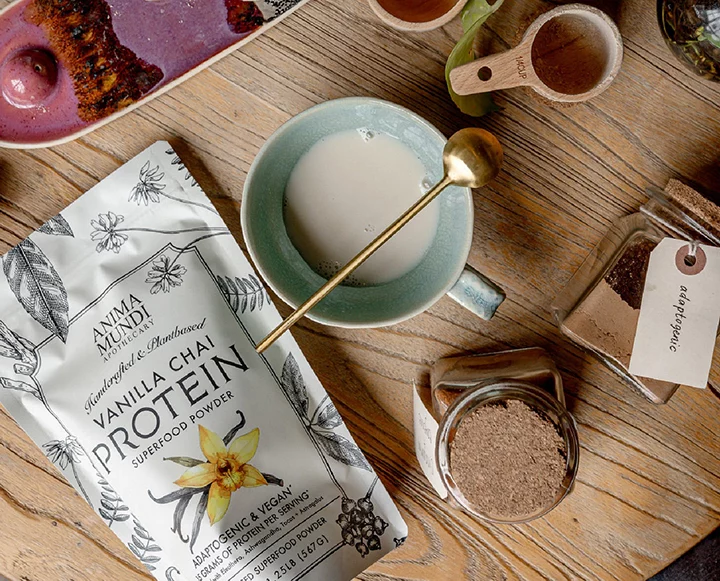The world’s healthiest foods all have one thing in common, and it has nothing to do with a ‘super’ status. The bioavailability of nutrients in our food is one of the most important and little talked about factors of good nutrition these days and we’re asking holistic nutritionist and hardcore fact nerd, Kelly LeVeque, to break down the concept for us kitchen to plate…
What is Bioavailability? Basically, your food may or (may not) contain adequate nutrition and you may (or may not) be able to absorb and utilize it. Your ability to absorb the nutrition from your food is a deeply complex subject that depends on the nutrition-source quality, age and preparation, along with your biochemistry’s ability to break it down via enzymes, hydrochloric acid and gut bacteria – and that doesn’t include the complexities post-absorption (but we will leave that for another biochemistry class).
Today, lets focus on what to do to increase the bioavailability of the food we eat. Simply put, here are the main factors driving the bioavailability of the nutrition in your food – and tips to maximize:
GO For Variety
There is no sugar coating it, the nutrition in your produce varies greatly. A study reviewing the differences in growing conditions including soil health, sunlight time and water content (not an organic vs. non-organic study) concluded vast differences in iron, calcium, magnesium and phosphorus; tomatoes’ iron content ranged a jaw dropping 1ppm to 1938 ppm and calcium in lettuce ranged from 6 meq/100gm to 71 meq/100gm.
At this point, any claim that you are getting 20% of your RDA of calcium from romaine lettuce on a health blog is reaching, at best. And the nutrient levels are actually deteriorating. The American College of Nutrition hammered that point home by publishing a landmark study out of UT Austin by Dr. Davis reviewing the nutritional data for 43 different vegetables and fruits, finding “reliable declines” in the amount of protein, calcium, phosphorus, iron, riboflavin (vitamin B2) and vitamin C over the past half century. Davis chalks up the decline to agricultural practices designed to improve traits (size, growth rate, pest resistance) other than nutrition.
Pro Tip: Although you can’t control the decline in produce nutrition, you can eat a variety of produce to help increase nutrient variety. Consider purchasing spouts of full-grown produce like broccoli, arugula and cilantro. These small week-old plants serve up sometimes 14 times the nutrition of their full-grown counterpart.
Know The Dirty Truth
It isn’t just about growing the plant in a chemical-free environment but building and supporting that soil ecosystem though traditional composting, aerating and root spacing to really get the best nutritional yield. According to SARE, biologically healthy soil contains a multitude of different microorganisms from bacteria and fungi to larger organisms like earthworms and ground beetles. This type of thriving soil produces a well-decomposed organic matter and healthy soil that holds onto calcium, magnesium and potassium, keeping these nutrients in the plants’ root zone. Our soils are essentially stripped; it isn’t enough to just purchase “organic,” you need to be asking your producers the right questions.
Pro Tip: Ask your organic farmers about their soil practices? How do they increase health of their soil?
Buy Fresh + Local
Once you pick the right produce, eat it ASAP! Plants lose nutrients after they are picked, through a natural process called respiration (get a breakdown at the bottom of this page). Essentially the plants are using their own stored nutrients to stay alive by breaking down and releasing nutrients – this process is exacerbated by warm temperatures, rough handling across states (or countries) and the cellular respiration rate of the specific vegetable or fruit. If the respiration rate is high, you should be eating that produce as close to its pick-date as possible, which means shopping at a local farmers market for fresh produce. For example, freshly harvested broccoli has a very high respiration rate and even though refrigeration slows deterioration, research out of Berkeley published in Nature showed that vitamin C levels were undetectable 7 days post harvest. If you can’t find local organic broccoli a frozen organic option would be better.
Pro Tip: Buy local, consume “highest respiration rate” (see list below) first and store produce in proper fridge temperatures.
Start Sprouting
Anti-nutrients like phytates and lectins, found in rice, nuts and seeds, make nutrients less bioavailable in our body. Most often anti-nutrients are the plant’s basic self-defense mechanism, like phytates, which bind with zinc, iron, and calcium in the GI tract, making them inaccessible. The good news is soaking and/or sprouting deactivates anti-growth enzymes enhancing the bioavailability of nutrients like vitamin C, folate, zinc, iron and calcium while leading to reduction in carbohydrates and an increase in protein.
Pro Tip: Soak and/or sprout nuts, seeds, beans and grains before consumption. Learn how to do it here!
COmbine Cooked + Raw
The answer totally depends on the produce you consume and nutrients you are looking to absorb. Many vitamins can be lost with cooking, including both fat-soluble and water-soluble vitamins like A, D, E, B1, B5, C, B12 and folate. On the other hand, the bioavailability of some minerals and phytochemicals is enhanced with cooking, like calcium, iron, lycopene and potassium.
Pro Tip: Mix it up! Eat both raw and cooked vegetables throughout the day. An easy tip is to split your produce from the farmers market and prepare it both ways. For example, enjoy raw mushrooms and onions on a spinach salad for lunch and sauté them up for a savory side at dinner.
Chew Like You mean It
Optimal digestion occurs in phases, including chewing, digestive enzymes and stomach acid, which all work to breakdown our food and unlock the nutrition within. First, as you chew your food, the enzyme amylase present in saliva breaks down carbs and starch. Then your stomach releases proteases (these are protein-digesting enzymes, such as pepsin) and hydrochloric acid, which kills or inhibits bacteria and provides the acidic pH of 2 for the proteases to work. More digestive enzymes are then released from the pancreas into the stomach and small intestines including: pancreatic proteases (such as trypsin and chymotrypsin), which help to digest proteins and pancreatic amylase, which helps to digest carbohydrates (sugars) and pancreatic lipase, which helps to digest fat. Unfortunately, stress, medications and poor food choices can contribute to the lack of enzyme and HCL production, which can decrease the bioavailability of the nutrition from our food.
Pro Tip: Chew your food completely. Consider enjoying a blended meal like a Be Well Smoothie. Consider supplementing with digestive enzymes. Check with a functional MD about being tested for low hydrochloric acid and/or supplementing with betaine HCl.
Get Gut Healthy
Inside your colon lives a microbiome; this bacterial ecosystem accounts for the majority of cells in your body and functions to help breakdown and ferment undigested carbohydrates also known as insoluble fiber. This process results in the subsequent absorption of short-chain fatty acids as well as the creation of vitamins such as vitamin K, vitamin B12, thiamine and riboflavin. Therefore, the bioavailability of certain nutrients depends on the thriving ecosystem living in your gut.
Pro Tip: Avoid antibiotics, birth control, pesticides and chemicals in food that breakdown healthy gut bacteria. Limit sugar, alcohol and white carbohydrates that feed yeast and candida in the gut. Eat fiber and resistant starch to help feed your healthy gut bacteria. Consider taking a probiotic to enhance microbiome proliferation.
Cheat Sheet: Respiration Rates of Food
Very Low
Dried fruit and nuts.
Low
Apples, garlic, grapes, onions, potatoes (mature), sweet potatoes.
Moderate
Apricots, cabbages, carrots, figs (fresh), lettuce, nectarines, peaches, pears, peppers, plums, potatoes (immature), tomatoes.
High
Artichokes, Brussels sprouts, cut flowers, green onions, snap beans.
Extremely High
Asparagus, broccoli, mushrooms, peas, sweet corn.
The Chalkboard Mag and its materials are not intended to treat, diagnose, cure or prevent any disease. All material on The Chalkboard Mag is provided for educational purposes only. Always seek the advice of your physician or another qualified healthcare provider for any questions you have regarding a medical condition, and before undertaking any diet, exercise or other health related program.













